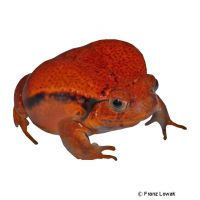False Tomato Frog (Dyscophus guineti)
| False Tomato Frog Dyscophus guineti | |
|---|---|
| Name | False Tomato Frog |
| Name Lat. | Dyscophus guineti |
| Synonym | Southern Tomato Frog |
| Family | Narrow-mouthed Frogs |
| Family lat. | Microhylidae |
| Order | Frogs & Toads |
| Order lat. | Anura |
| Origin | Madagascar |
| Habitat | Tropical forest |
| Diet | Small live insects |
| Humidity | 80-90 % |
| Behavior | Peaceful, nocturnal |
| Keeping | Pair, group |
| Care Level | Difficult |
| Breeding | Difficult |
| Housing | Humid terrarium |
| Life Span | 10 years |
| Protection | CITES Appendix II; EU Annex B |
| Metric Units | |
| Size | 6-10 cm |
| Temperature | 24-28 °C |
| Housing Size | 60 x 40 x 40 cm |
| US Units | |
| Size | 2.4"-4" |
| Temperature | 75-82 °F |
| Housing Size | 25" x 15" x 15" |
Distribution and habitat
The crepuscular to nocturnal tomato frogs are found in the coastal regions of southern Madagascar, where they live in the tropical forests near small temporary or perennial waterholes, usually hiding under foliage buried in the ground, lurking for prey.
Maintenance
For 1-2 animals the terrarium size should be at least L 60 x W 40 x H 40 cm. The terrarium should be placed in a quiet, vibration-free place without sunlight.
You will need a spacious terrarium with a diggable substrate of loose, absorbent, non-rotting substrate such as. Sand-peat mixture, coconut fibers or Sphagnum moss with a drainage and a large, shallow water basin, in addition branched, preferably entwined by climbing plants shelter and climbing branches, back and side wall coverings of e.g. tree fern plates (Xaxim) and a dense planting (e.g. Tradescantia, Ficus, Scindapsus, ferns, bromeliads). Potted plants that can be easily removed for cleaning are advantageous. At least twice a day the inside of the terrarium must be finely sprayed with water (humidity), but a rain or mist system is better.
| Temp. day: 24-28 °C | Temp. night: 22-24 °C | Humidity: 80-90 % |
Thermostatically controlled floor heating (heating mats) is recommended. The lighting duration must be 10-14 hours depending on the season. Daylight fluorescent tubes with low UV content are very suitable.
Diet
The diet consists of live insects such as crickets, grasshoppers, cockroaches and crickets, as well as mealybug larvae, zophobas and earthworms. After a period of habituation (feeding with tweezers), special ready-made food for insectivores available in specialized shops is often accepted as well. Food should be offered to adult animals 2-3 times a week, young animals must be fed daily. Feeding should be done in the evening hours. It is important to add minerals and vitamins regularly (e.g. by dusting the feeders). The quality of the feeders can be enhanced by feeding overripe fruit and honey water. A regular and varied diet prevents deficiency symptoms.
Reproduction and breeding
The much smaller males have a yellowish coloration on the back, while the larger females are red-orange. Mating can be triggered by turning off the lights for 2-3 days, reducing the temperature to 22 °C and then simulating rain. The female ready to spawn is taken in the mating grip (amplexus) by the male and lays about 1000-1500 eggs in roundish spawning balls in the water. The larvae (tadpoles) hatch after only 36 hours and initially feed on microorganisms from the water and later eat animal and plant food. After 2-3 months, the transformation (metamorphosis) is complete and the frog leaves the water. Life expectancy can be over 10 years.
Species protection
The animal population must be reported in writing to the responsible authority immediately after the beginning of the keeping. It is essential to find out about any bans on keeping or permits for keeping dangerous animals in your state or municipality (e.g. public order office).
Protection of species: WA Annex II; EU Annex B. The proof of purchase is the required proof of origin for the animal. Please keep it safe! Your pet store will be happy to provide you with further information.
Important
Dyscophus antongilii is very similar to Dyscophus guineti, and the scientific distinction is unclear. When threatened, tomato frogs inflate their bodies and secrete a toxic, rubbery skin secretion that can occasionally cause skin irritation and swelling when touched. Before purchasing, a terrarium should be prepared that meets the species specific needs. Good ventilation without drafts is necessary, as well as equipment for measuring temperature and humidity. The lighting has to correspond to the species-specific day-night rhythm and should be placed in such a way that the animals cannot injure themselves. The terrarium should be locked in such a way that neither unauthorized persons can open it nor the animals can escape
Further information can be found in your pet store.
References
Text: petdata; Image: Franz Lowak
Source: VDA & DGHT (2006): Haltungsrichtlinien für die Haltung von Anuren; ENGELMANN (2006): Zootierhaltung - Tiere in menschlicher Obhut: Reptilien und Amphibien, Harri Deutsch Verlag
- Gemäß § 21 Abs. 5 Tierschutzgesetz idgF
